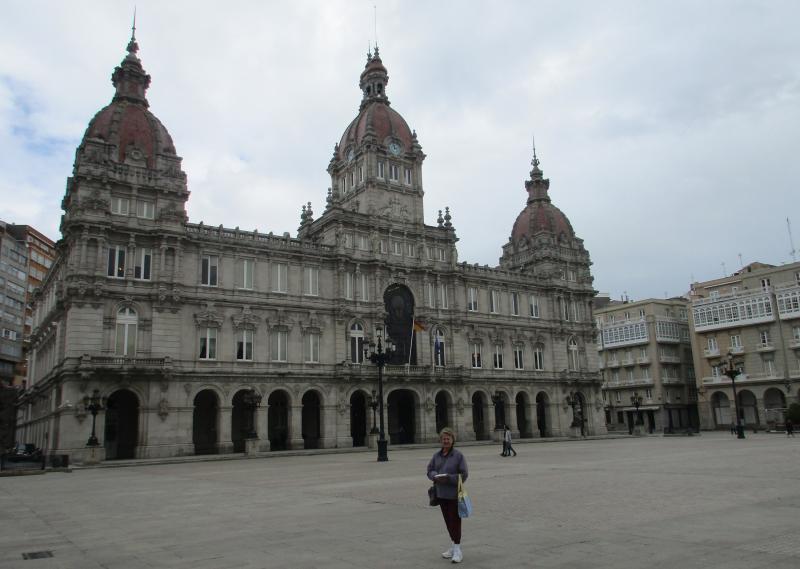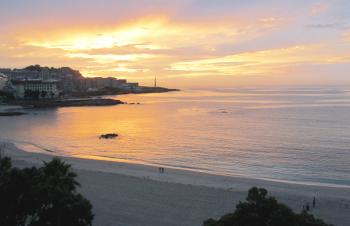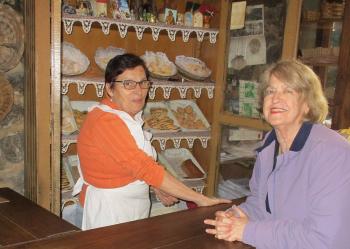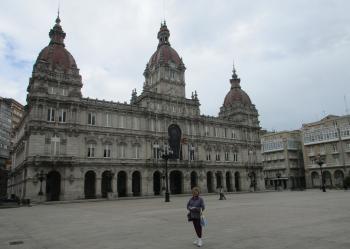An independent tour of Galicia, Spain’s hidden gem
This article appears on page 43 of the February 2018 issue.
Having traveled extensively in Spain over the years, in May 2017 we set our sights on an area new to us, the rugged region of Galicia, in the northwest corner of the country.
Because I am a military retiree, we are able to catch hops on US military aircraft to many wonderful destinations, and getting to Spain from Charleston, South Carolina, was relatively easy. Our 8-hour flight from Charleston to a Navy base in Rota, about two hours by bus south of Seville, delivered us there in mid-morning.
Just off base, we went straight to a local travel agency, Paco Travel, to arrange the beginning of our trip. We don’t like to plan ahead too much; serendipitous travel is our style.
Flights from Seville to the major Galician cities do not run frequently, but we found a great one leaving the next morning. We traveled by bus to Seville and on to Seville’s airport the next morning. In just over an hour, a comfortable nonstop Vueling Airlines flight took us to A Coruña (aka La Coruña in Castilian Spanish), a thriving city near Spain’s northwest tip.
A Coruña
Our first impressions of A Coruña — from our over-the-water descent to the lush green scenery, the unique Galician architecture and our “room with a view” overlooking the beach at Hotel Riazor (Avda. Pedro Barrie de la Maza 29), which cost about €75, or $90, per night with breakfast — were very positive and justified our decision to explore this seldom-visited region of Spain.
We were not the first to discover this magnificent corner of Spain. The Romans, who came and settled this beautiful seaside region thousands of years ago, built what is today the oldest continually operational lighthouse (yes, it still functions) in the world, the Tower of Hercules.
We climbed all 234 steps to the top of the tower, together with many other visitors, and were rewarded with wonderful views of the city, its ports and sweeping beaches. The only downside of being in A Coruña was that there were three cruise ships in port on one day, which brought thousands of tourists there to flood its sites, bars and cafés. As in Barcelona, Ketchikan, etc., the cruise industry has had a powerful impact on this previously untouched northwest corner of Spain.
Exploring A Coruña, with its unique Galician galerias (glass-fronted balconies), the magnificent Plaza de María Pita and the charming Old Town with its Synagogue Street (hinting of the Jews who once lived there), was a delight.
A casual, fresh-fish lunch near Plaza de María Pita at Marisquería O’Calexo (Rúa Franja 19), serving traditional Galician food, was delicious and inexpensive (under €10 each). And to our surprise, our hotel was just steps from Casa Museo Picasso (Calle Payo Gómez 14), where, from age 9 to 13, Picasso lived with his family near the art school where he studied, initially under the guidance of his father, a teacher at the school.
Venturing to Vigo
After a 3-night stay in A Coruña, we left this gem of a city and headed south on a 1½-hour fast train to Vigo to continue exploring this special part of Spain. Fortunately, our very comfortable, modern 4-star boutique hotel in Vigo, Agua de Mar (Calle Lepanto 12), was just a stone’s throw from the Vigo-Urzáiz train station and well located for our stay there. (We booked our room through an online booking site for €75 per night.)
A city bus on a circular route (which we boarded near our hotel) gave us a good introduction to Vigo, and the steep hills (like those in San Francisco) gave our hearts and legs a rigorous workout!
At the top of our list was the tiny medieval Casco Vello (Old Town), situated on a steep hill with a jumble of narrow cobblestone lanes named Basketmakers’ Street, Hatmakers’ Street, etc. We had this area virtually to ourselves, as the city was void of conspicuous visitors during our stay.
On a surprisingly warm and sunny day (it is often overcast and chilly in Vigo), we enjoyed a delicious al fresco lunch of local specialties on a flower-filled Old Town restaurant terrace at Restaurante Don Quijote (Rúa de Laxe 4). We enjoyed the Menú del Día (less than €10 per person) and a sweeping panoramic view of the busy port below.
Our day came to a delightful and relaxing conclusion with creative, complimentary tapas served at several bars.
Galicia’s Jewish past
Our trusty, old-but-still-useful Lonely Planet guidebook convinced us to spend an extra day in Vigo to explore one of the best Jewish heritage sites in all of Europe: the little town of Ribadavia.
From Vigo-Guixar station, we took a marvelous, early-morning, 1½-hour trip by local train past rolling hills and rushing rivers and through vineyards and thick, green, wooded forests to Ribadavia. The only tourists in town, it appeared, we headed uphill for a fascinating excursion.
While Ribadavia is famous as the center of the Ribeiro white-wine industry of Galicia, our focus was its Jewish history. Some say this was home to 1,500 Jews in the Middle Ages who prospered there until their expulsion in 1492.
In Ribadavia’s Jewish Quarter, we found streets with names like Jerusalem Street, a building that might have been the town’s synagogue and a fabulous bakery (Tafona da Herminia, Travesía Porta Nova 2) selling traditional Sephardic cookies, including one in the shape of a Star of David. (We munched on a sample of these artisanal delights on our return train trip!)
In Ribadavia’s main square, Praza Maior, we found the excellent Jewish Information Centre of Galicia, with a museum that shared with us the story of Jewish history in the region. The Jewish Quarter there is one of the best-preserved historical Jewish sites in Spain.
Pontevedra and points beyond
In less than 15 minutes by fast train from Vigo-Urzáiz station we were in Pontevedra, once Galicia’s largest city and the place where the Santa María, Columbus’ flagship, was built. The delightful Pontevedra of today is more tranquil, and, with several buildings of historical interest, it was the perfect place for a short stay.
We stayed in Hotel Galicia Palace (Avda. de Vigo, 3) for about €65 per night. It was located within walking distance of the Old Town, with more than a dozen attractive colonnaded small plazas in its old quarter. We had a hard time selecting where to eat and drink in the area — so many choices! — but we settled on a fantastic gourmet find for lunch, Borona (Travesía del Comercio, 3), where we enjoyed the Menú del Día for about €10 per person.
With decent weather, our stay in Pontevedra was exactly what we needed before heading by train to the more tourist-centric Santiago de Compostela.
What a contrast the frantic crowds of Santiago were to the quiet beaches, cafés and vineyards of the four other Galician cities we had visited. Immediately upon our arrival, this most-visited city in Galicia felt like Disneyland, as throngs of tour groups, independent travelers, pilgrims, trekkers, bicyclists and others from all over the world crowded its narrow streets and lined up at its churches, bars and cafés.
Inside the Cathedral, we joined the hordes and descended below ground to glimpse the ornate silver tomb of (we were told) the Apostle Saint James, after whom the city is named.
For over a thousand years, faithful pilgrims have made the nearly 500-mile trek on the Camino de Santiago (Way of St. James) across northern Spain in reverence.
The Cathedral and its surrounding museums were the focus for us (and others). Unfortunately, the grand Portico of Glory, at the front of the Cathedral, was shrouded and covered with scaffolding, as the Cathedral was undergoing major renovations.
Nevertheless, we continued into the massive Cathedral, marveling at its grandeur, and visited the Cathedral museums, “home” to royal tombs, a magnificent old library, priceless Flemish and Spanish tapestries and other religious treasures.
Afterward, a guide explained the history of the site as we toured the Cathedral roof, giving us spectacular, panoramic views of the city.
Our last day in this city was unstructured and relaxing. Avoiding the packed streets on which we had previously found ourselves, we ventured farther afield, randomly discovering delightful plazas, leafy parks, quiet lanes and hidden narrow alleys. A fountain here and a sculpture there, a street juggler and a Galician bagpiper viewed from a café terrace, all were delightful pleasures. We even found a tiny bit of the old Jewish quarter of Santiago de Compostela’s Ruela de Xerusalén (Jerusalem Alley).
In the “it’s a small world” category, we bumped into and had coffee with the young lady who had been our guide at the Casa Museo Picasso in A Coruña over a week before.
It was time to say adiós to this lovely corner of Spain. We boarded a high-speed train for the pleasant journey back and headed south, via Madrid, to Seville on another high-speed train, continuing to the Rota Navy Base, where we caught a flight back to Charleston, concluding our latest marvelous Spanish odyssey.
Reflections
Once home and recovering from jet lag, we looked back on our time in Galicia, an area vastly different from the rest of Spain.
They speak a different language, Galego, which is far older than the Castilian Spanish spoken elsewhere in Spain. The Galician culture is related to that of the Celts, explaining the haunting sounds of bagpipes that we often heard throughout the region.
And it was not surprising that this coastal region is very big on seafood, especially octopus (pulpo) and shellfish. The fresh-from-the-sea fish we tasted was delicious.
While most of Spain is dry and brown in the summer, the rain-drenched and windswept region of Galicia was lush and green, with verdant misty mountains, rushing torrents and dense forests. Fog drifting in from the sea in the mornings turned into sunny afternoons, and its beaches and bays were stunning as well.
We were delighted to have had the experience.




